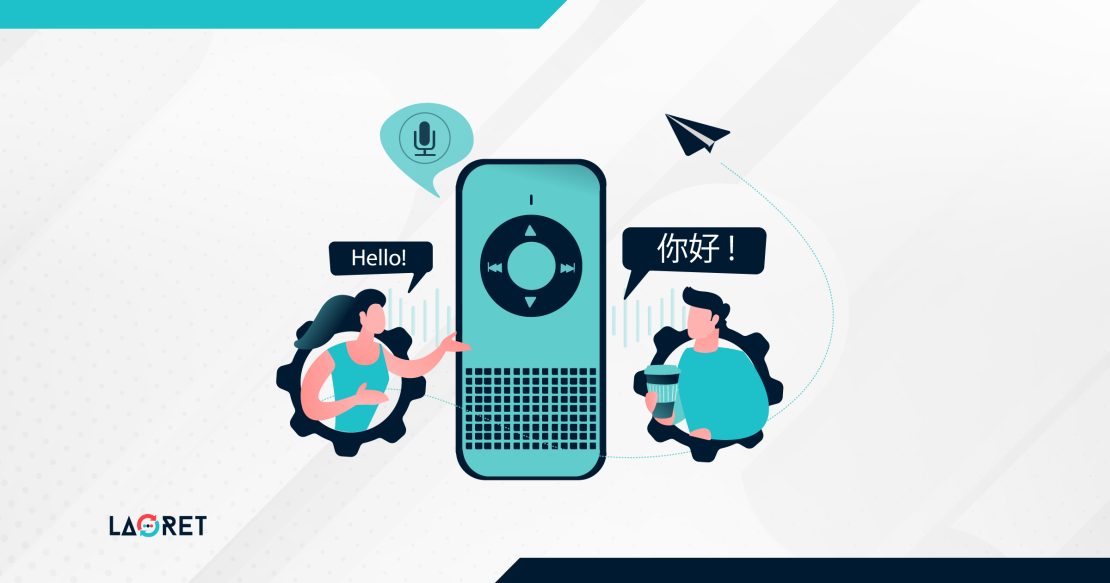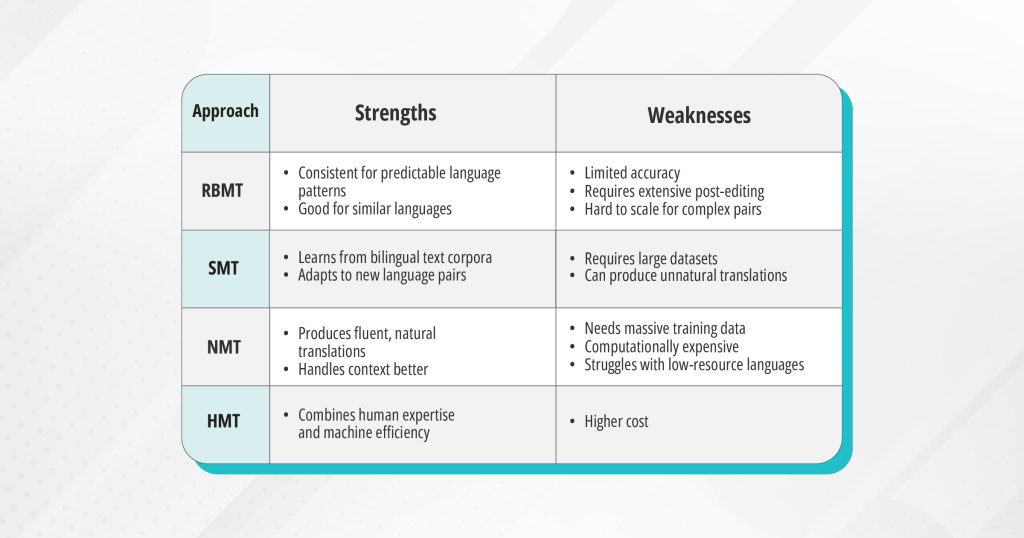Exploring the Different Types of Machine Translation
Exploring the Different Types of Machine Translation
With the unprecedented growth Machine Translation has seen in recent years, the interest in MT has been increasing more than ever.
This rise in interest isn’t just about speed, though. It’s about the incredible leaps in quality MT has made, especially when paired with the finesse of human post-editing.
But the tools we use today are very different from the basic ones we started with. The development of machine translation is a story of constant improvement, from simple rules to complex systems that almost seem to understand language like humans do.
In this blog post, we’ll take a closer look at the different types of machine translation that are changing the way we communicate globally. We’ll cover everything from the early rule-based systems to the latest neural machine translation technology.
Types of Machine Translation: A Timeline of Key Developments
At its core, machine translation (MT) software uses computers to translate text. And while human post-editing remains essential to achieve the same level of quality as fully human translation, MT has gained huge interest from those seeking speed, consistency, and cost-effectiveness.
So, now, where did this technology begin, and what milestones have shaped its evolution? To understand how this machine translation software evolved let’s go back in time to learn a brief history of machine translation systems!
Early Ideas (17th Century – 1933):
- Philosophers like Leibniz and Descartes proposed theoretical codes for language translation, but no machines were built.
- Soviet scientist Peter Troyanskii designed a mechanical translation machine using cards, a typewriter, and a camera, but it was never completed.
Early Experiments (1949 – 1964):
- Warren Weaver’s 1949 paper sparked US research into machine translation.
- The first public machine translation experiment took place in 1954, translating Russian sentences into English.
- The Association for Machine Translation and Computational Linguistics was formed in 1962.
- The ALPAC committee was formed in 1964 to study machine translation.
Practical Applications & Commercialization (1970 – 1996):
- In 1970, the French Textile Institute used machine translation for multilingual abstracts.
- Trados pioneered commercial translation memory technology between 1984 and 1989.
- Systran offered free online machine translation in 1996, although quality was limited.
The Rise of Statistical & Neural MT (2000s – Present):
- Tech giants like Google, Facebook, and Microsoft began investing heavily in machine translation research in the early 2000s.
- Google Translate launched in 2006, gaining popularity for its accessibility.
- By 2014, neural machine translation (NMT) emerged, offering significantly improved accuracy and fluency by translating whole sentences instead of individual words.
A Closer Look at the Different Types of Machine Translation
All types of machine translation software have revolutionized the translation process, ensuring efficient linguistic conversion from the source language to the target.
However, the defining factor in the evolution of different MT types lies in the quality of the output and how closely it approaches the nuances of human translation.
Today, even with the level of quality machine translation has reached, a hybrid approach to using machine translation systems, which combines the strengths of machine translation with human post-editing is becoming very popular, particularly for tasks like software localization and other complex ones, where accuracy and context are key.
Let’s take a closer look at the different types of machine translation and their unique features.
1. Rule-Based Machine Translation (RBMT):
Rule-Based Machine Translation (RBMT) relies on predefined linguistic rules and dictionaries to translate text. It functions by breaking down the source text and analyzing its grammatical structure to generate the translated output.
The rules are created by language experts and programmers who have invested significant effort in understanding and mapping the rules between two languages. RBMT depends on translation lexicons that are built manually. Some of these lexicons can be edited and refined by users to enhance the quality of the translation.
That is why RBMT is useful for basic translations, particularly for languages with similar grammatical structures. It can serve as a foundational approach for machine translation, especially for languages with predictable patterns and structures.
However, it has some limitations, including
- Limited accuracy
- Extensive need for human post-editing
- Difficulty in scaling for complex language pairs
2. Statistical Machine Translation (SMT):
Statistical Machine Translation (SMT) works by using statistical models based on large bilingual corpora (existing human translations) to translate text. These models analyze the frequency of word sequences and phrases in the source and target languages to generate translations.
Then It applies the translation model to the second language and convert those elements into the new language.
SMT can handle larger volumes of text and requires less manual rule creation, making it more scalable. And compared to the RBMT, SMT is more accurate.
However, SMT still has limitations. It struggles to capture nuanced language, context, and cultural references, which can result in translations that may not fully convey the original meaning.
3. Neural Machine Translation (NMT):
Neural Machine Translation (NMT) is a cutting-edge approach to machine translation that utilizes artificial intelligence and neural networks to learn and translate languages, simulating the functioning of the human brain.
NMT differs from traditional rule-based and statistical machine translation by processing entire sentences at once, rather than breaking them down into smaller parts.
NMT works by employing a large neural network to consider the entire context of a sentence and generate a translation that is more fluent and accurate. This is in contrast to the phrase-based or hierarchical models used in SMT.
NMT boasts several strengths, including significantly higher accuracy and fluency compared to previous machine translation approaches. It has the capability to capture context and nuances more effectively, leading to translations that better convey the original meaning.
Despite its strengths, NMT has some limitations:
- Requires massive amounts of training data to perform optimally, demanding significant time and resources
- Computationally expensive, needing substantial processing power and memory
- Struggles with low-resource languages due to insufficient training data
NMT is particularly effective for languages with complex structures and contexts where other machine translation tools might fall short. NMT is a great choice for organizations looking to provide natural-sounding translations for a better user experience or for tasks that demand high-quality translations, like customer communications or content localization.
4. Hybrid Machine Translation (HMT):
Hybrid Machine Translation HMT works by integrating multiple translation engines such as RBMT, SMT, and NMT and leveraging their respective capabilities to generate more precise translations.
For instance, it might use RBMT for languages with similar grammatical structures, SMT for handling large volumes of text, and NMT for capturing nuanced language and context. This integrated approach allows HMT to take advantage of the strengths of each individual translation method.
The strengths of HMT lie in its improved translation quality by combining knowledge and capabilities of various translation models. This mix of RBMT, SMT, and NMT, HMT can provide translations that are more accurate, fluent, and contextually relevant.
However, HMT also has its weaknesses. Integrating multiple translation engines can be complex and resource-intensive. It requires effective coordination and management to ensure the seamless functioning of different translation components.
As expected, the performance of HMT is only as strong as the individual translation engines it integrates, so any weaknesses in those engines can potentially impact the overall translation quality.
 Finding the Perfect Fit: Matching MT Types to Your Translation Needs
Finding the Perfect Fit: Matching MT Types to Your Translation Needs
When it comes to finding the perfect fit in machine translation, it’s essential to consider various factors to match MT types to your translation needs. This process can be challenging, but by carefully evaluating the following factors, you can make an informed decision.
Let’s walk through what you should think about:
Factors to Consider
-
Translation Quality Requirements
Think about how accurate and fluent your translations need to be. For instance, if you need high-quality, nuanced translations for technical documents, you might lean towards a specific MT type that excels in technical language.
So, you will not go to the basic RB machine translation for example because it struggles to keep pace with different languages and complex data. But you may opt for Neural Machine Translation as it has higher accuracy.
-
Content Type and Domain
Different MT types are tailored to excel in specific content domains, such as technical, legal, or marketing. For example, if you’re translating legal documents, you’d want an MT type that is designed to handle legal terminology and nuances effectively.
And this legal terms not only require AI models they also need highly attentive human translators to understand the hidden meaning of legal texts.
-
Language Pair
The complexity of your language pair and available training data can greatly affect MT performance. For languages that are very different from each other, select an MT type that offers strong language support and plenty of training data.
-
Budget and Time Constraints
Consider how much you’re willing to spend and how quickly you need the translations. The cost and speed of different MT types can vary widely. For instance, while a particular MT type might offer higher quality translations, it could come with a higher price tag and longer processing times compared to other options. Balance these factors based on your priorities.
Decision-Making Framework
You might still be confused about which machine translation approach or model you should choose for your business. So we have simplified the choice for you:
- RBMT: Ideal for basic translations with simple language pairs and minimal quality needs.
- SMT: Suitable for larger text volumes; may need post-editing for better quality.
- NMT: Best for high-quality translations, handling complex language pairs and nuanced content.
- HMT: Offers higher accuracy for specific domains or language pairs, combining human expertise.
Ensure Accurate Translations With Laoret
With so many options you need experts to know how to deal with each translation document with great accuracy using machine learning.
Why bother yourself and risk your business growth when you can partner with a translation services company?
Machine translation has come a long way since its inception, and whether you need machine translation or machine translation post-editing, here at Laoret we understand the ins and outs of utilizing AI and machine learning to produce high-quality translations. Our expertise ensures accurate and natural translations with professional human post-editing.
Contact us at Laoret to benefit from our advanced language solutions and ensure that your translation needs are met with the highest level of accuracy and professionalism.


 Finding the Perfect Fit: Matching MT Types to Your Translation Needs
Finding the Perfect Fit: Matching MT Types to Your Translation Needs

